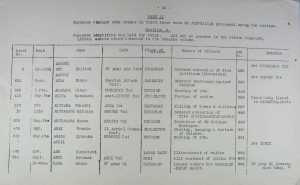So much has been written about World War II. People know all about the battles and the dropping of the atomic bombs, etc. However, to me the most fascinating period of the war was its immediate aftermath.
After several years of warfare, when the world had been turned upside down, how did you then turn it back upright? That was an enormous task, and I am in awe of the people who succeeded in doing that.
I have been looking through the materials that the National Archives of Australia has digitized (oh I love the people there, whoever they are!!!) and they have a lot on that period.
The Australians were deeply involved in the effort to identify Japanese who were guilty of war crimes so that they could be brought to justice. This was extremely complex and difficult, as they had to find people who could verify the identity of Japanese soldiers, and confirm that they had committed crimes.
Obviously, and rightly so, the Australians were primarily concerned with bringing to justice Japanese who had committed crimes against Australians. As an historian of the Southeast Asian past, however, I’m interested in trying to understand what Southeast Asians experienced during the war. And I just came across an interesting document that gives a sense of this.
Apparently there were Japanese who had served on the island of Borneo during the war who were subsequently imprisoned on the island of Labuan, off the northern coast of Borneo. I found a list of the Japanese who were there after the war awaiting trial for crimes committed against people other than Australians.
This list indicates what each Japanese soldier was being charged with.
Akita Masohura was being charged with torturing a native in Jesselton (Kota Kinabalu). Akiyama Takashi – the killing of women and children in Sandakan. Arai Toshio – the beating, hanging and torture of Chinese in Jesselton. Azui Katsumi – the ill-treatment of coolies in Lahad Datu. Chikazawa Masku – the massacre of 28 Chinese hostages in Loepang. Egawa Yoshitaro – the torture of Chinese in Kuching. Egashira Kiyochi – the killing of Leano (a native) in Beaufort. Ehara Kesao – the killing of 30 Chinese in Sandakan. Fujihara Eijiro – the massacre of 16 Chinese in Lutong. Fujino Tsunekichi – ordering the execution of Indian prisoners of war in Kuala Belait. Fukushima Yoshiaki – the killing two Chinese women in Lahad Datu. Furukawa Kiyoo – the killing of two US airmen and numerous Chinese in Beaufort. Furno Sutero – the torture of native civilians in Kuching.
The list goes on and on and on. . .
[The images here come from pages 101 and 102 of the following file: A4311 747/5 Australian War Crimes Commission – War crimes investigations – Final report North Borneo]


